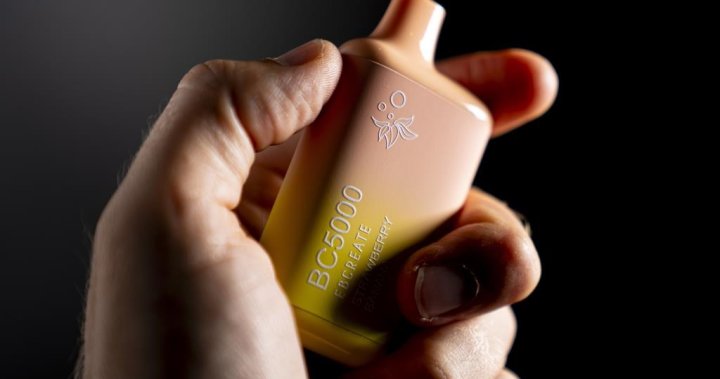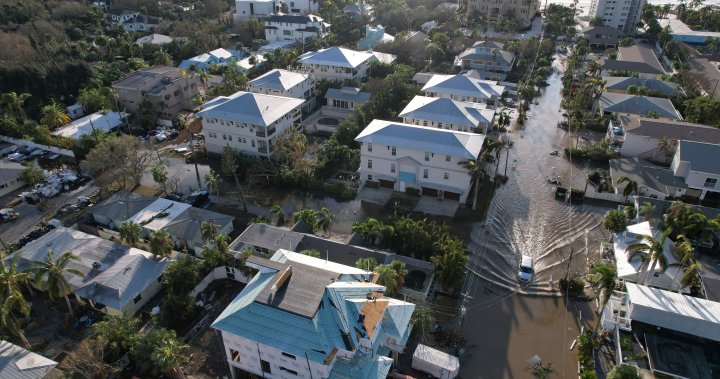A new study from Ireland has found that flavoured vapes may produce over 100 toxic chemicals that cause immediate harm when inhaled.
Vaping products work by heating chemicals to high temperatures that form an aerosol that is then inhaled. The study, published in Nature on Wednesday, used artificial intelligence to see how chemicals from 180 vape flavours transform and affect the human body when heated.
It noted that the chemicals used in e-liquids tend to derive from food and cosmetics, meaning they are not specifically developed for vaping. Mixtures are most commonly made with vegetable glycerin, according to Health Canada.
When these chemicals are heated to high temperatures with inhalation into the lungs, they produce “unknown secondary chemical entities,” the study says.
The researcher’s AI tool categorized these unknown chemicals and found about 127 acute toxins, 153 health hazards and 225 irritants in the studied vaping products.
Acute toxins are described as harmful chemicals that produce immediate adverse effects, even from a single dose of a substance.

Donal O’Shea, an author of the study, says the sheer array of “health hazard chemicals” people are exposed to every time they inhale from a vape is shocking.
“That’s the take home message, I guess, is that if you heat a chemical, it tends to turn itself into a variety of different chemicals which we should not be inhaling into our lungs,” O’Shea told Global News.
He says exposure to an acutely toxic chemical creates a high risk of “immediate serious injury,” if the dose is high enough.
Toxins from vapes linked to serious health conditions
Previous studies have also found that some flavoured vaping products produce dangerous chemicals. Between 2017 and 2019, researchers at Health Canada found about 22 chemicals in vaping products sold in Canada.
A U.S. study published in April found that vaping may increase the risk of exposure to lead, uranium and cadmium which cause systemic harm to young people in particular.
The latest health and medical news
emailed to you every Sunday.
Exposure to these toxins was linked to an increased risk of osteoporosis and cancer in the nasopharynx, lung, breast, pancreas, prostate and bladder.
Despite a slight decrease in youth vaping rates, data released last year revealed that Canadian teenagers still have some of the highest rates of e-cigarette use globally.
Given the many vape devices and flavours on the market around the world, O’Shea says it would take a very long time for scientists to track every chemical they produce. That’s why his team opted to use AI to get an estimate of the chemical composition of 180 flavours by simulating how they decompose when heated in high temperatures. This process is called heat-induced pyrolysis.
Nearly every flavour analyzed by the AI showed at least one product classified as a health hazard.
“The accumulation of these toxins, even a very low dose over years, is causing at a cellular level, damage in the lungs and maybe beyond the lungs, depending upon the compound itself. So then you just have a slow build-up of damage that leads to progression to different diseases,” O’Shea said.

In 2021, the Canadian federal government announced it would ban most vape flavours and reformulate existing flavours with ingredients approved by Health Canada.
Though these regulations haven’t come to fruition yet, flavoured vapes have already been banned in five provinces and territories: Quebec, New Brunswick, P.E.I., Nova Scotia and the Northwest Territories.
In an email to Global News Friday, Health Canada said Canadians have access to information about vaping in line with the recent Nature study on its website .
“Consistent with the scientific study recently published, Health Canada’s website informs Canadians that vaping aerosols produced during the heating of a vaping liquid can produce chemicals that are harmful or potentially harmful.”
The agency says using a vape is still less harmful than smoking tobacco from a cigarette.
“Young people and those who do not use tobacco products should not vape because it is not harmless,” it said.
Governments need to impose stricter regulations, researchers say
The research team at Dublin’s RCSI University of Medicine and Health Sciences concludes the study saying they hope the findings are used as an informative public health resource.
“As vaping is a new and unprecedented stress to the human body, with the ability to generate pyrolysis products more toxic that their parent compounds, it seems prudent to strictly limit the number of chemical entities in e-liquids,” the study says.
O’Shea, who is also a chemistry professor at RCSI, says political leaders across the world need to “take on board the task of putting some regulation in place.”
There’s only so much parents can do to prevent youth from vaping, he says.
“I think we really do need some regulation to what chemicals are going in (vapes) and recognize that they’ve really never been tested for this type of use,” O’Shea said.
“So we have to take some responsibility here as the adults and as politicians to not let it get into the hands of our teenagers rather than just lecturing them that they shouldn’t.”
© 2024 Global News, a division of Corus Entertainment Inc.





